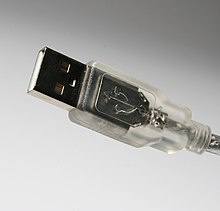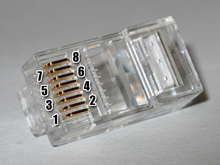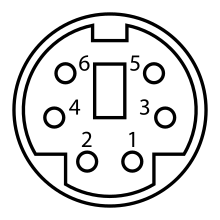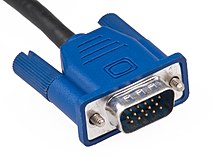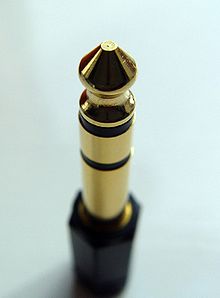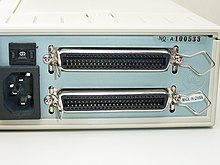Computer ports in common use cover a wide variety of shapes such as round (PS/2, etc.), rectangular (FireWire, etc.), square (Telephone plug), trapezoidal (D-Sub — the old printer port was a DB-25), etc. There is some standardization to physical properties and function. For instance, most computers have a keyboard port (currently a round DIN-like outlet referred to as PS/2), into which the keyboard is connected.
Electrical signal transfer
Electronically, hardware ports can almost always be divided into two groups based on the signal transfer:
- Serial ports send and receive one bit at a time via a single wire pair (Ground and +/-).
- Parallel ports send multiple bits at the same time over several sets of wires.
After ports are connected, they typically require handshaking, where transfer type, transfer rate, and other necessary information is shared before data are sent.
Hot-swappable ports can be connected while equipment is running. About the only port on personal computers that isn't hot-swappable is the keyboard PS/2 connector; *hot-swapping a keyboard on many computer models can cause permanent damage to the motherboard.*(source needed)[citation needed]
Plug-and-play ports are designed so that the connected devices automatically start handshaking as soon as the hot-swapping is done. USB ports and FireWire ports are plug-and-play.
Auto-detect or auto-detection ports are usually plug-and-play, but they offer another type of convenience. An auto-detect port may automatically determine what kind of device has been attached, but it also determines what purpose the port itself should have. For example, some sound cards allow plugging in several different types of audio speakers, then a dialogue box pops up on the computer screen asking whether the speaker is left, right, front, or rear for surround sound installations. The user's response determines the purpose of the port, which is physically a 1/8" tip-ring-sleeve (TRS connector) minijack. Some auto-detect ports can even switch between input and output based on context.
Currently (2006) manufacturers have nearly standardized on colors associated with ports on personal computers, although there are no guarantees. The following is a short list:
Main article: PC System Design Guide
- Orange, purple, or Grey: Keyboard PS/2
- Green: Mouse PS/2
- Blue or magenta: Parallel Printer DB-25
- Amber: Serial DB-25 or DB-9
- Pastel pink: Microphone 1/8" stereo (TRS) Minijack
- Pastel green: Speaker 1/8" stereo (TRS) Minijack
FireWire ports used with video equipment (among other devices) can be either 4-pin or 6-pin. The two extra conductors in the 6-pin connection carry electrical power. This is why a self-powered device such as a camcorder often connects with a cable that is 4-pins on the camera side and 6-pins on the computer side, the two power conductors simply being ignored. This is also why laptop computers usually only have 4-pin FireWire ports, since they cannot provide enough power to meet requirements for devices needing the power provided by 6-pin connections.
Note that optical (light) fiber, microwave, and other technologies (i.e., quantum) have different kinds of connections, since metal wires aren't effective for signal transfers with these technologies. Optical connections are usually a polished glass or plastic interface, possibly with an oil that lessens refraction between the two interface surfaces. Microwaves are conducted through a pipe, which can be seen on a large scale by examining microwave towers with "funnels" on them leading to pipes.
Hardware port trunking (HPT) is a technology that allows multiple hardware ports to be combined into a single group, effectively creating a single connection with a higher bandwidth, sometimes referred to as a double-barrel approach. This technology also provides a higher degree of fault tolerance since a failure on one port may just mean a slow-down rather than a dropout. Compare this to Software Port Trunking (SPT) where two agents (websites, channels, etc.) are bonded into one with the same effectiveness, i.e. ISDN B1 (64K) plus B2 (64K) equals data throughput of 128K.
[edit] Example ports
| USB | |||
| Firewire | |||
| Ethernet port | |||
| Serial port | |||
| Parallel port | IEEE 1284 | ||
| PS/2 connector | |||
| Video Graphics Array VGA connector | |||
| Digital Visual Interface | |||
| TRS connector | |||
| SCSI | |||
| DC connector | |||
| IEC connector | IEC 60320 |


